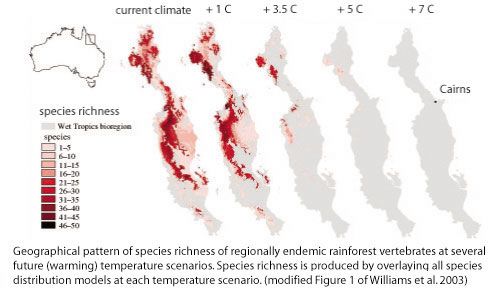 |
Conservation
of the Australian Wet Tropics
Our collaborative research offers valuable insights into
how history (both pattern and process) may inform future conservation
strategies in the Australian Wet Tropics (AWT) World Heritage
Area. Knowledge of demographic and spatial responses to past
climate change in relation to current ecological properties
should help to refine predictions of future response, and
thereby help to target monitoring and conservation efforts
to protect unique biodiversity. Several salient themes for
the conservation-minded, taken from previous evolutionary
research, include the following: 1) the significance of protecting
both historically isolated lineages (ESUs) and contiguous
environmental gradients to maintain population viability and
adaptive genetic diversity (Moritz 2002), 2) the efficiency
of using persistent historical refugia within taxa as a surrogate
for predicting phylogenetic diversity within another taxa,
relates to vagility and/or degree of specialisation (e.g.
low vagility snails predict vertebrate clade distributions,
but not vice versa)(Hugall et al. 2002) 3) the geographic
scale of taxonomic response to shared history of climate-driven
habitat change varies significantly (Moritz et al. 2004).

Recent analyses based on bioclimatic distribution modeling
suggest climate change is potentially a greater threat than
habitat loss to biodiversity in the AWT and analogous rainforest
systems (Thomas et al. 2003). The AWT is particularly sensitive
to climate change for two reasons: (i) its biogeographic and
evolutionary history has resulted in an endemic fauna that
is mainly adapted to a cool (upland), wet and relatively aseasonal
environment; and (ii) it is dominated by steep elevational
gradients across which impacts of increasing temperatures
should be most noticeable (Nix 1991, Williams et al. 1996).
It is of great concern that montane rainforests in several
of the ancient refugia and areas of highest conservation value
(Moritz et al. 2001; Moritz & McDonald, in press) are
predicted to contract markedly under scenarios of slight (1º
C) warming (Hilbert et al. 2001). Indeed, Williams et al.
(2003) suggested that the endemic vertebrates would, on average,
lose ~35% of their current distribution area with a 1º C rise
and could suffer 50% extinction if the temperature rises by
3.5º C, a midrange prediction under the IPCC scenarios. Future
research will focus on developing a better understanding of
how lineage-specific ecology predicts responses to historical
rainforest contractions.
|
 |
